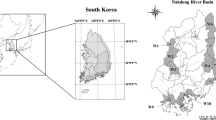Abstract
In this study, a probabilistic analysis using first-order reliability method is conducted to predict the reoccurrence of drought conditions. The implementation of the model involves the collection of the long-term average data during 1994–2015 from 609 study areas of Iran. The reliability criterion is defined as the changes in groundwater resource index during the years 1994–2004. Three parameters, including the beta index, the limit state function, and the probability of failure, are obtained using Kriging GeoStatistical analysis method to produce continuous layers. The results show that around 1900 selected points belong to definite drought conditions, and a major part of the other points are being exposed to a steady rise in the depth of water in aquifers with a probability of more than 50%. The spatial distribution of these changes shows that large parts of the eastern coastal aquifers, as well as major aquifers along the longitudinal Zagros range, and large parts of Fars province, are exposed to the reduction in groundwater level with a probability of more than 95%. In addition, the visual comparison of predicted drainage quality maps suggests a high correlation between the probability of occurrence and repetition of drought conditions with the specific drop in drinking water quality potential index classes. The results of this study confirm the drought reoccurrence conditions for predicting negative changes in standard drinking water quality.





Similar content being viewed by others
References
Ahmad Z, Rahim N, Bahadori A, Zhang J (2017) Improving water quality index prediction in Perak River basin Malaysia through a combination of multiple neural networks. Int J River Basin Manag 15:79–87
Ang AH-S, Tang WH (1984) Probability concepts in engineering planning and design. Decision, Risk, and Reliability, vol 2, 1st edn. Wiley
Banerjee P, Prasad R, Singh V (2009) Forecasting of groundwater level in hard rock region using artificial neural network. Environ Geol 58:1239–1246
Beck MB (1987) Water quality modeling: a review of the analysis of uncertainty. Water Resour Res 23:1393–1442
Chandramouli V, Lingireddy S, Brion G (2007) Robust training termination criterion for back-propagation ANNs applicable to small data sets. J Comput Civil Eng 21:39–46
Charulatha G, Srinivasalu S, Uma Maheswari O, Venugopal T, Giridharan L (2017) Evaluation of ground water quality contaminants using linear regression and artificial neural network models. Arab J Geosci 10:1–9
Der Kiureghian A, Dakessian T (1998) Multiple design points in first and second-order reliability. Struct Saf 20:37–49
Gutmann E, Pruitt T, Clark MP, Brekke L, Arnold JR, Raff DA, Rasmussen RM (2014) An intercomparison of statistical downscaling methods used for water resource assessments in the United States. Water Resour Res 50:7167–7186
Jalalkamali A, Moradi M, Moradi N (2015) Application of several artificial intelligence models and ARIMAX model for forecasting drought using the Standardized Precipitation Index. Int J Environ Sci Technol 12:1201–1210
Jang YS, Sitar N, Der Kiureghian A (1994) Reliability analysis of contaminant transport in saturated porous media. Water Resour Res 30:2435–2448
Jeffrey Starn J, Green CT, Hinkle SR, Bagtzoglou AC, Stolp BJ (2014) Simulating water-quality trends in public-supply wells in transient flow systems. Groundwater 52:53–62
Jothiprakash V, Sakhare S (2008) Ground water level fluctuations using artificial neural network. In: The 12th international conference of international association for computer methods and advances in geomechanics (IACMAG), pp 1–6
Maier HR, Lence BJ, Tolson BA, Foschi RO (2001) First-order reliability method for estimating reliability, vulnerability, and resilience. Water Resour Res 37:779–790
Mendicino G, Senatore A, Versace P (2008) A Groundwater Resource Index (GRI) for drought monitoring and forecasting in a mediterranean climate. J Hydrol 357:282–302
Mohanty S, Jha MK, Kumar A, Sudheer K (2010) Artificial neural network modeling for groundwater level forecasting in a river island of eastern India. Water Resour Manage 24:1845–1865
Nayak PC, Rao YS, Sudheer K (2006) Groundwater level forecasting in a shallow aquifer using artificial neural network approach. Water Resour Manage 20:77–90
Nourani V (2017) An emotional ANN (EANN) approach to modeling rainfall-runoff process. J Hydrol 544:267–277
Qaderi F, Babanejad E (2017) Prediction of the groundwater remediation costs for drinking use based on quality of water resource, using artificial neural network. J Clean Prod 161:840–849
Sahoo MM, Patra K, Swain J, Khatua K (2017) Evaluation of water quality with application of Bayes’ rule and entropy weight method. Eur J Environ Civil Eng 21:730–752
Salazar AA, Wurbs RA (2004) Conditional reliability modeling of short-term river basin management. J Water Resour Plan Manag 130:450–459
Sitar N, Cawlfield JD, Der Kiureghian A (1987) First-order reliability approach to stochastic analysis of subsurface flow and contaminant transport. Water Resour Res 23:794–804
Starn JJ, Bagtzoglou AC, Robbins GA (2013) Uncertainty in simulated groundwater-quality trends in transient flow. Hydrogeol J 21:813–827
Wu X, Lu Y, Zhou S, Chen L, Xu B (2016) Impact of climate change on human infectious diseases: Empirical evidence and human adaptation. Environ Int 86:14–23
Acknowledgements
The authors thank Ministry of Energy of Iran for the valuable support of this research.
Author information
Authors and Affiliations
Corresponding author
Additional information
Editorial responsibility: Hari Pant.
Rights and permissions
About this article
Cite this article
Azimi, S., Azhdary Moghaddam, M. & Hashemi Monfared, S. Analysis of drought recurrence conditions using first-order reliability method. Int. J. Environ. Sci. Technol. 16, 4471–4482 (2019). https://doi.org/10.1007/s13762-018-1845-1
Received:
Revised:
Accepted:
Published:
Issue Date:
DOI: https://doi.org/10.1007/s13762-018-1845-1




